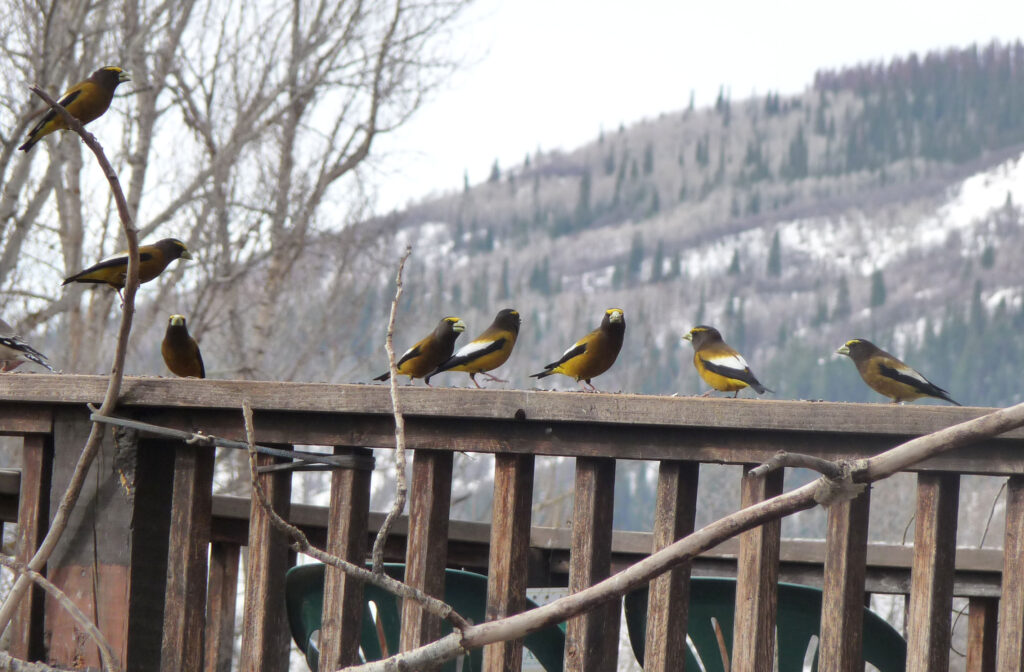A Further Look At The Enigma That Is The Evening Grosbeak

Last time we talked about some of the things that make the evening grosbeak so interesting and somewhat mysterious. It’s always been one of my favorites so there’s plenty more to say about it. This week we’re going to explore the challenge of observing them in the wild, some of the Native American folklore associated with this enigmatic bird, and how to attract them to your yard.
How And Where To Look
Birdwatching the evening grosbeak can be something of a challenge due to their nomadic wanderings and irruptive migrations. We talked last time about how they are particularly difficult to observe during the nesting season so summer is the least optimal time to catch a glimpse of them. You’ll have better luck in the spring, autumn and winter.

By Remydee1 – Own Work, CC BY-SA 4.0,
https://commons.wikimedia.org/w/index.php?curid=124265184
Look for them in coniferous forests in the northern U.S. and western mountain regions as well as southern Canada. They can also be found in deciduous forests where maple, beech or box elder are predominant. As their name suggests, they tend to be most active in the late afternoons up until dusk.

Image By Mike’s Birds from Riverside, CA, US -, CC BY-SA 2.0,
https://commons.wikimedia.org/w/index.php?curid=63823372
Their call is fairly distinctive and somewhat loud so you may hear them before you see them. When they gather in large flocks, it’s mostly a noisy cacophony but usually you can catch some individuals singing solo. The tune is typically clear and flutelike, with some variation from bird to bird. Males are louder and their call is more elaborate while the female’s song is simpler and more subdued. You can hear a sample by clicking below.
Associated Folklore
The Evening Grosbeak holds significant symbolism in Native American folklore and cultural traditions. It is considered symbolic of things like abundance, communication, social harmony, healing and spiritual guidance.
Among the Haida people of the Pacific Northwest, the evening grosbeak is associated with healing and well-being. Its feathers are believed to possess medicinal properties and are used in ceremonial rituals to promote physical and spiritual healing.
The Ojibwe people believe that the Evening Grosbeak is a messenger of the Great Spirit. Its presence is seen as an indication of positive changes, good fortune, and the arrival of abundance. The bird’s distinctive call is considered a form of communication from the spiritual realm.
The Blackfoot tribe holds the Evening Grosbeak in high regard as a symbol of social harmony and cooperation. According to their folklore, when an Evening Grosbeak is seen, it signifies the need for open communication, understanding, and unity within the community.

Image By Frank Kovalchek CC BY 2.0
https://commons.wikimedia.org/w/index.php?curid=33732650
Among the Lakota Sioux, the Evening Grosbeak is considered a sacred bird associated with spiritual guidance and protection. It is believed that the bird’s presence brings blessings and offers a connection to the spirit world. The Lakota Sioux also associate the bird with the concept of balance and harmony in both the physical and spiritual realms.
The Mohawk people have stories that depict the Evening Grosbeak as a wise and knowledgeable bird. In Mohawk folklore, the Evening Grosbeak possesses the ability to understand both the language of humans and the language of the natural world. It is seen as a teacher and a source of wisdom, offering guidance and knowledge to those who listen.
Invite Them To Your Yard
When I was growing up in Northern Wisconsin, flocks of evening grosbeaks would visit for several days, once or twice a year. They can be a challenge to attract, but it’s well worth the effort.

Image By Robert Taylor from Stirling, ON, Canada
CC BY 2.0,
https://commons.wikimedia.org/w/index.php?curid=81786590
To create their preferred environment, plant conifers like spruce or pine and hardwoods like maple and box elder. Fruiting trees like elderberry, hawthorn and mountain ash, and blueberry or raspberry bushes help entice them as well.

Image By Andy Reago & Chrissy McClarren, CC BY 2.0
https://commons.wikimedia.org/w/index.php?curid=37121432
Bird baths are always a good idea, as well. Just make sure you thoroughly sanitize them several times per week.
Sunflower seeds are the main event when trying to attract the evening grosbeak. Tube feeders are a little small for them so go with fly-through or platform feeders. Just be ready to refill it in a hurry if a flock comes to visit. They’re voracious.

Image By gailhampshire from Cradley, Malvern, U.K
P1020399, CC BY 2.0,
https://commons.wikimedia.org/w/index.php?curid=50577966
* * * * * * * * *
So there you have it. The evening grosbeak is a fascinating and enigmatic bird that’s a favorite of birdwatchers in much of North America. Their bright coloring, clear song and flocking behavior make them a joy to behold. They were widely respected and admired by numerous Native American peoples, and I’m sure you’ll appreciate them, too.
By Steven Roberts



